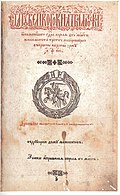Belarusian language
The Belarusian language (беларуская мова, biełaruskaja mova) is an Eastern Slavic language and an Indo-European language.
| Belarusian | |
|---|---|
| беларуская мова / biełaruskaja mova | |
| Native to | Belarus, Poland, in 14 other countries |
| Ethnicity | Belarusians |
| Native speakers | 10 million (2007)[1] |
| Language family | Indo-European
|
| Early forms: | Old East Slavic
|
| Writing system | Cyrillic (Belarusian alphabet) Belarusian Braille Belarusian Latin alphabet |
| Official status | |
| Official language in | |
| Recognised minority language in | |
| Regulated by | National Academy of Sciences of Belarus |
| Language codes | |
| ISO 639-1 | be |
| ISO 639-2 | bel |
| ISO 639-3 | bel |
| Linguasphere | 53-AAA-eb < 53-AAA-e (varieties: 53-AAA-eba to 53-AAA-ebg) |
 Belarusian-speaking world Legend: Dark blue - territory, where Belarusian is the main language | |
It is spoken in Belarus and eastern Poland (in the area of Białystok). It is also spoken by Belarusians who live in other countries of Europe, Australia, and North America.
Belarusian is written by either the Cyrillic alphabet or the Latin alphabet.
Belarusian is an Endangered language, as it has a low rate of speakers in its native countries.
Belarusian Language Media
The Casimir's Code of 1468, in Ruthenian
The third Lithuanian statute of 1588, all three written in Ruthenian
Ruthenian Bible by Francysk Skaryna, 1517, first ever book printed in Eastern Europe
The cover of the copy of the Dictionary of the Belarusian Local Tongue by Ivan Nasovič preserved at the Francis Skaryna Belarusian Library and Museum
The 1926 Belarusian Academic Conference on Reform of the Orthography and Alphabet in Minsk
Bilingual Belarusian–Russian sign in Belarusian town Rakaw in 2014
References
| This language has its own Wikipedia project. See the Belarusian language edition. |
- ↑ Nationalencyklopedin "Världens 100 största språk 2007" The World's 100 Largest Languages in 2007
- ↑ У Падляшскім ваяводстве беларуская мова прызнана афіцыйнай
- ↑ European Charter for Regional or Minority Languages








